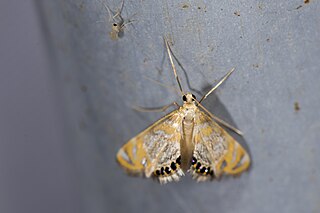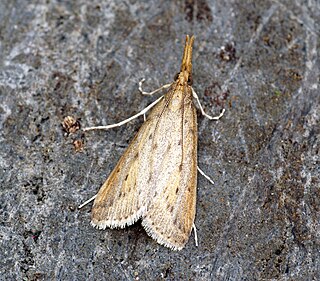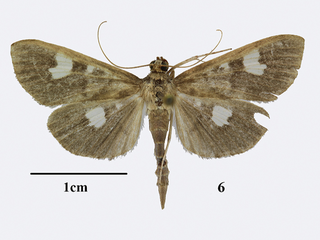
Crambidae comprises the grass moth family of lepidopterans. They are variable in appearance, with the nominal subfamily Crambinae taking up closely folded postures on grass stems where they are inconspicuous, while other subfamilies include brightly coloured and patterned insects that rest in wing-spread attitudes.

The Pyralidae, commonly called pyralid moths, snout moths or grass moths, are a family of Lepidoptera in the ditrysian superfamily Pyraloidea. In many classifications, the grass moths (Crambidae) are included in the Pyralidae as a subfamily, making the combined group one of the largest families in the Lepidoptera. The latest review by Eugene G. Munroe and Maria Alma Solis retain the Crambidae as a full family of Pyraloidea.

The Pyraloidea are a moth superfamily containing about 16,000 described species worldwide, and probably at least as many more remain to be described. They are generally fairly small moths, and as such, they have been traditionally associated with the paraphyletic Microlepidoptera.

Lygodium microphyllum is a climbing fern originating in tropical Africa, Southeast Asia, Melanesia and Australia. It is an invasive weed in Florida where it invades open forest and wetland areas. The type specimen was collected in the vicinity of Nabúa, on the island of Luzon in the Philippines by Luis Née.

Ancylolomia is a genus of moths of the family Crambidae described by Jacob Hübner in 1825.

Calamotropha is a genus of moths of the family Crambidae.

Eoophyla is a genus of moths of the family Crambidae. It was erected by Charles Swinhoe in 1900.

Eudonia is a large and widespread genus in the grass moth family (Crambidae), subfamily Scopariinae. There is no common name for the roughly 250 species placed here; new species are still being described regularly. Although the genus was proposed early in the 19th century, many of these moths were for a long time retained in Scoparia, the type genus of the subfamily and a close relative of Eudonia. A few small genera have been proposed for separation from Eudonia, but given the size of this group this is not particularly convincing; thus, all are retained here pending a comprehensive phylogenetic review.

Evergestis is a genus of moths of the family Crambidae described by Jacob Hübner in 1825. A number of species are pests, including the cross-striped cabbageworm, a pest of cole crops such as cabbage.

Nymphicula is a genus of moths of the family Crambidae.

Palpita is a genus of moths of the family Crambidae. Members of the moth genus Stemorrhages may be very similar in appearance.

Scoparia is a grass moth genus of subfamily Scopariinae. Some authors have assigned the synonymous taxon Sineudonia to the snout moth family (Pyralidae), where all grass moths were once also included, but this seems to be in error.

Euchromius ocellea, the necklace veneer or belted grass-veneer, is a cosmopolitan migratory species of moth of the family Crambidae, first described by Adrian Hardy Haworth in 1811. It has Hodges number 5454.

Glaphyriinae is a subfamily of the lepidopteran family Crambidae. It was described by William Trowbridge Merrifield Forbes in 1923. The subfamily currently comprises 509 species in 75 genera.
Musotiminae is a subfamily of the lepidopteran family Crambidae. It was described by Edward Meyrick in 1884

Schoenobiinae is a subfamily of the lepidopteran family Crambidae. The subfamily was described by Philogène Auguste Joseph Duponchel in 1846.

Scopariinae is a subfamily of the lepidopteran family Crambidae. The subfamily was described by Achille Guenée in 1854.
Glyphodes metastictalis is a moth in the family Crambidae. It was described by George Hampson in 1899. It is found on Sulawesi in Indonesia.
Eugene Gordon Munroe was a Canadian entomologist who discovered numerous species of insects. He worked for the Insect Systematics and Biological Control Unit, Entomology Division in Ottawa, Ontario, Canada.

Agroterini is a tribe of the species-rich subfamily Spilomelinae in the pyraloid moth family Crambidae. The tribe was erected by Alexandre Noël Charles Acloque in 1897.















